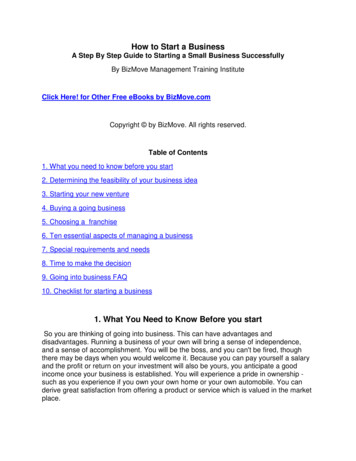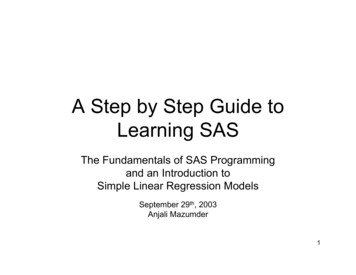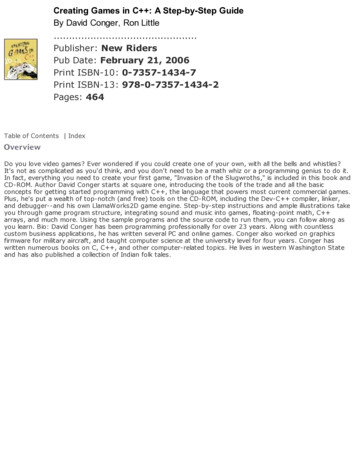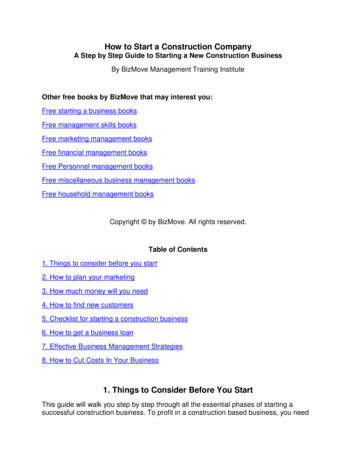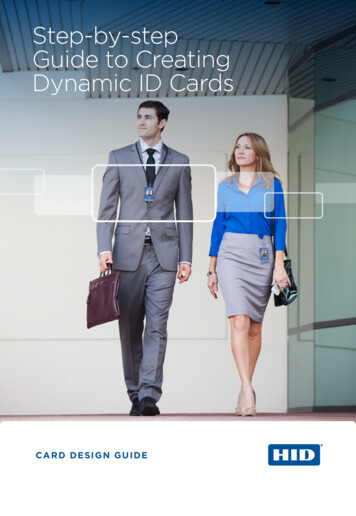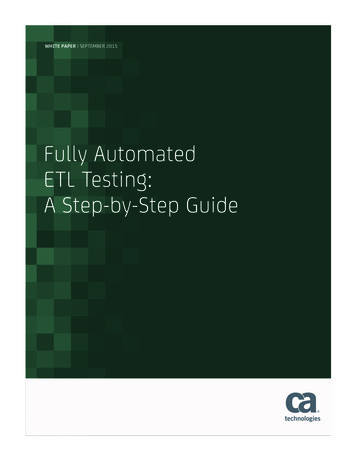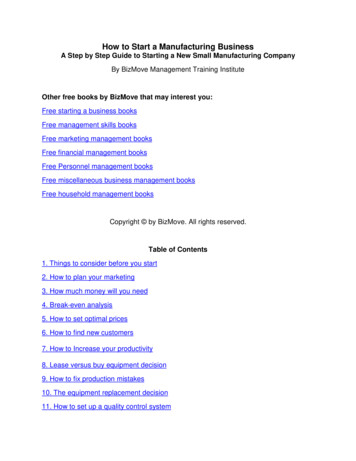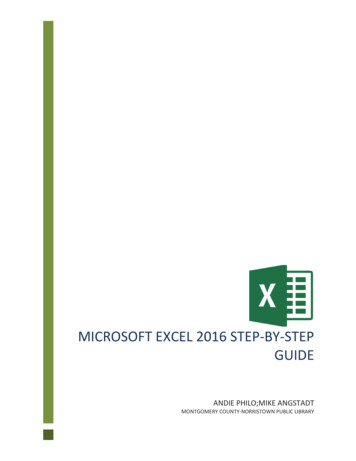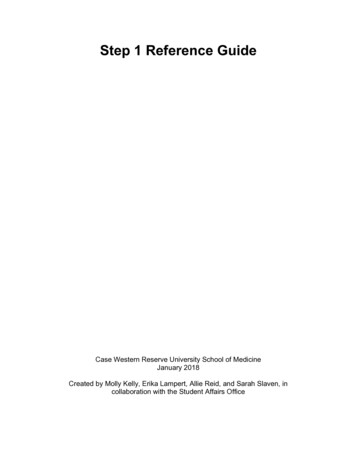
Transcription
Step 1 Reference GuideCase Western Reserve University School of MedicineJanuary 2018Created by Molly Kelly, Erika Lampert, Allie Reid, and Sarah Slaven, incollaboration with the Student Affairs Office
Table of ContentsContentPage1. About the Resource Guide . 32. Step 1: The Basics . 43. Studying: When, Where, and Howa. Did students study before their dedicated study periods? . 5b. For how many weeks did students study? . 6c. Where did students study? 7d. How, generally speaking, did students organize each day? . 7e. When did students take practice exams? . 7-84. Studying: Whata. Which resources were most commonly used? . 9b. Resource-by-resource advice . 9-195. Wellness . . 20-216. Final Advice: “What would you have done differently?” 222
About the Resource GuideCase’s student community has always been a great source of information andsupport. For instance, each year, the incoming first year class gets a thoroughrun down of campus, the city of Cleveland, and strategies to successfully mastera massive amount of information. We feel most would agree that over the firsttwo years, a huge thank you is owed to the classes above us who helped makethe transition smooth.When the time came to begin preparing for step 1, many of us felt overwhelmedand confused. There did not seem to be much organized information about how,what, or when to study. Those of us who had friends in the M3 and M4 classesrelied heavily on their advice, but for students who didn’t know manyupperclassmen, there was little information available to help them confidentlyprepare (besides a couple of study guides that many later found to be too rigidand impractical).This guide was created in an attempt to consolidate the massive amount ofinformation about step 1 into one place. It’s also meant to show that there aremany ways to successfully study for, and take, step 1. The emphasis on wellnessis also intentional: many of us did not anticipate how anxious and truly unhappywe would feel, and only later did we realize that most of our peers felt the sameway. We hope that by acknowledging this up front, future classes will be betterequipped to handle the inevitable stress that comes with preparing for the exam.Fifty-nine M3 students from both Case and Lerner were surveyed, and thefollowing pages summarize their responses. All responses were analyzedseparately; if there were significant differences in their responses to particularquestions, their answers will be displayed separately. It is our hope that this effortcan be expanded upon in the years to come to help future M2s feel moreinformed about planning and studying for step 1.Good luck!Molly, Erika, Allie, & SarahJanuary 20183
Step 1: The BasicsHow do I sign up?Before you can choose a test date and location for step 1, you must submit anapplication for a USMLE scheduling permit. When you submit this application,you will also be required to choose a three-month window during which you wantto schedule your exam. The permit will allow you to pick an exam ONLY duringthis three-month window (if you wish to change the window at a later date, thereare fees). The 2017 fee for the USMLE scheduling permit was 605.Apply here: https://apps.nbme.org/nlesweb/#/authenticateAfter filling out the application, you will receive a Certificate of Identification andAuthorization Form that is pre-populated with your information. This form needsto be signed by the school registrar and then sent to the NBME. Please note thatthis form also requires a 2” x 2” passport-style photo, which you affix to the form.The registrar will mail this form for you; once the NBME receives it, you will getan email containing your Step 1 permit. Once you have this permit, you mayregister for your exam.What is the test like?Step 1 is a one-day exam administered on a computer. It consists of seven 60minute sections, and each section has 40 questions. Occasionally, you may havea section with a few fewer than 40 questions, too. You are given 45 minutes ofbreak time that you may use in-between sections however you would like. Thetesting software looks quite similar to that of U-world, so it navigating betweenquestions on test day should not be difficult.Prior to beginning the exam, there is a 15-minute tutorial. If you skip the tutorial,these 15 minutes will be added to your total break time, giving you one hourinstead of 45 minutes. You can view the tutorial ahead of time by accessing thefollowing link: orientation.nbme.org/Launch/USMLE/STPF1In the exam room, you are given:- Double-sided dry erase sheet dry-erase marker- Noise cancelling headphones (which you can use only if you wish to do so)- Audio headphones (parts of the exam do have audio)You are not allowed to bring food/drink into the exam room with you, but you maykeep it in a locker outside the exam room.During breaks, you are allowed to access anything in your locker, including yourcell phone, any study materials you wish to review, food, drink, etc.4
Studying: When, Where, and HowShould I start reviewing before my dedicated study time?Each student is inevitably going to have a different opinion on this. Of note, theoverwhelming majority of Case students noted that looking back, if they hadstudied anything beforehand, it would have been pharmacology only.5
Studying: When, Where, and How, cont.How long should I study for?Again, there is a good amount of variability regarding this question. Here’s whatstudents said:6
Studying: When, Where, and How, cont.Where should I study?Case and Lerner students answered thisquestion pretty similarly: about 2/3 ofstudents stayed in Cleveland to prepare,while about 1/3 went home. A couple ofstudents also split time between homeand Cleveland.How should I organize my day?Excluding half- or full days off, moststudents reported 10-12 hours spentstudying each day. Students tended tospend a half to two thirds of the day onquestion sets – that is, answeringquestions, reviewing the explanations,and annotating relevant material intoFirst Aid. Most students reported 2-3sets per day; many added in anadditional set as they became moreefficient.Per student report, the other one third toone half of the day was spent on micro,pharm, or other content review, mostcommonly with First Aid or Pathoma.When should I take practice exams?Students reported different approaches to timing of practice exams. A generalapproach endorsed by many was one exam at the start of study period, oneexam after first pass of material, and several additional exams during repeatedpasses of material, as the exam date drew closer.For more information about when students timed their practice tests, check outthe graphs on the following page.What should I use to study?See the Resources section for more information about which resources weremost commonly used and tips about how to use resources effectively.7
Studying: When, Where, and How, cont.8
Studying: WhatWhich resources were most commonly used?Both Case and Lerner students reported using a very similar list of resources:How do I use these resources?In the following pages, we have attempted to summarize what studentsrecommend for each resource, listed alphabetically. When applicable, we havealso included download links. Note that some have longer explanations thanothers; this reflects how many students provided feedback for each resource,and how valuable students felt each resource was.9
Studying: What, cont.ANKI BROSENCEPHALON CARDSA collection of 13,000 flashcards created and continuously edited by medicalstudents. Each card is tagged so cards can be sorted by category/organ system.Cost: freeDownload here: ncephalon was king if you start early in M2 or M1; it is not so good forclasses, but dedicating a bit of time each day to memorizing cards from therelevant block proved to be nice when dedicated came around months later. Ionly did the sections I felt weak in.”BOARDS AND BEYONDCollection of 300 review videos organized by topic/organ system, with USMLEstyle quiz questions at end of each video.Cost: varies depending on length of subscriptionDownload here: https://www.boardsbeyond.com/signupTry sample videos before purchasing: https://www.boardsbeyond.com/samples“Really well made videos explaining everything. Used for areas of weakness.”“I wish I found this earlier in my studying. Awesome resource for teachingrelevant anatomy. The neuro and cardio chapters are gold.”DOCTORS IN TRAININGReview course with videos and written workbook designed as a comprehensivereview of step 1 content.Cost: 825Download here: 1/“Did one video and quit. I don't think it's a high quality resource, but if you lackthe organizational skills to coordinate your own study program this might be agood option for you.”“Helpful, but too many videos and took too much time. Was helpful in topics that Ifelt I needed more attention (e.g. ophtho stuff, interpreting EKG).”“I preferred this style of learning. More engaging and structured. Wouldrecommend annotating First Aid with materials from the DIT videos.”“Watched a few of their vids when I was struggling w/ cards pharm.”10
Studying: What, cont.FIRECRACKERFlashcard-based program that reviews material covered in First Aid andPathoma; can organize cards based on topic or complete them randomly. Alsooffers practice exams.Cost: varies depending on length of subscriptionDownload here: http://www.firecracker.me/pricingCan do seven-day free trial before purchasing“Used it very peripherally, before the exam period, did not like since it had somany questions that I felt were too specific and would never be asked.”“I used Firecracker during blocks 3 and 4. I am not someone who remembersdetails without the larger context so I did not find this mode of studying useful.”“Used it very peripherally, before the exam period, did not like since it had somany questions that I felt were too specific and would never be asked.”FIRST AIDMost students use this as their central reference and annotate informationgathered from other resources and Q-banks into First Aid. This provides a solidframework for studying, especially during first pass, and then can be used asreference during later passes. First Aid includes all of the testable informationand topics but does not contain any in-depth explanations; thus, it is best usedfor review and memorization, not for primary learning.Most students made it through First Aid 2-2.5 times, and some made it through 3times. Those that only made it through once commented that they wished theyhad done it a second time.Some students read through FA prior to the dedicated study period but many didnot. While the dominant strategy was to annotate all of the other resources intoFA, some students did not like having to read and memorize from a book andinstead made flashcards of the information found in FA.Cost: 50 on Amazon“For the first half of my study period, I annotated everything that I reviewed intoFirst Aid. After taking my first practice NBME, I realized I had not nailed down alot of small details that are in First Aid. I spent the second half of my study timereally reading over First Aid (I got through it three times over the 8 weeks) andcapturing those details, and it made a huge difference in my score on practicetests. Getting my first aid spiral bound was also helpful (Staples can do this for 5- 10).”11
Studying: What, cont.“Helpful: Covers a lot of information, diagrams/images were helpful.Not helpful: Did not find information to be formatted for easy reading, ended upcreating my own sets of flashcards with facts from chapters I really did not wantto read again.Utilization: Read through each chapter 1x, then created flashcards for annoyingchapters, continued to reread better chapters. Continued reading chapters/doingflashcards every day until my test date.”“The bible, well organized and it slowly was rooted into memory. Find a way tosystematically annotate because it will be important (i.e. color coding, highlightingetc.) I annotated FA with all novel notes from UWorld (in blue) and Pathoma (inred), and anything from curriculum (in black) that came up when I delved deeperto answer a question - rarely tapped into curriculum but had an old FA that wasannotated from school studying.”“Absolutely the best resource. Went through the entire book 1x before dedicated,then 2-3 more times during dedicated depending on the chapter. The first twotimes I went through it, I just read and underlined. Then I started handwritingnotes on sections that I needed extra attention with.”FREE 120Three blocks of 40 questions each, written by the NBME, that may be takentimed or untimed. Is sometimes referred to as the “free 150” because olderversions of this resource had 50 questions per section.Cost: freeDownload here: his was the last ‘practice test’ that I took before my exam. This was the onlyresource I know of that let me practice listening to heart sounds exactly as I hadto on the actual exam.”LANGE PHARM CARDSFlashcards for pharmacology with each card designed as a mini-vignette.Many students did not find Lange Pharm Cards to be particularly helpful. Theyare structured with a scenario vignette on the one side and details about the drugclass that would be used on the other side. The drug class information was verydetailed and thus students often found it hard to commit to memory using theseflash cards alone.Cost: 1212
Studying: What, cont.“I used these to help with Pharm. I liked that they were presented with vignettesthat had all of the drug class information on the back. Pharm was the mostdifficult subject for me to get down for Step 1 because I didn't get a grip on how Iwa
Step 1: The Basics How do I sign up? Before you can choose a test date and location for step 1, you must submit an application for a USMLE scheduling permit. When you submit this application, you will also be required to choose a three-month window during which you want to schedule your exam. The permit will allow you to pick an exam ONLY during


